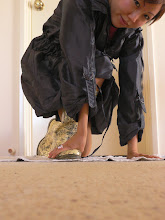She Loved Kopi & I loved Teh, And That Was the Reason We Couldn't Agree
 I have to confess that I have a bit of an addiction to coffee. I never use to get headaches from drinking coffee, but since the move to UK/Ireland for the past four years (where great tea is brewed and great coffee is scarce,) I grew out of the habit of drinking it. Consequently, whenever I drink a strong cup of coffee (like the kind from Ya Kun), I inevitably get a pounding headache - the kind that doesn't go away from practically the whole day no matter how much water I drink (or what I eat).
I have to confess that I have a bit of an addiction to coffee. I never use to get headaches from drinking coffee, but since the move to UK/Ireland for the past four years (where great tea is brewed and great coffee is scarce,) I grew out of the habit of drinking it. Consequently, whenever I drink a strong cup of coffee (like the kind from Ya Kun), I inevitably get a pounding headache - the kind that doesn't go away from practically the whole day no matter how much water I drink (or what I eat).Then I tell myself that I'm never going to drink coffee again, and tell my friends to stop me from buying coffee, but inevitably, I find myself queuing up for - yet another cup of coffee...... Then the pounding headache and heart palpitations start along with waves of guilt and remorse..... It's classic addict behaviour.
Although I do love my cappuccinos (the kind made from freshly ground beans, served up by a skillful coffee barista), there's just something about the coffee and teas in Singapore. Although the coffees are often made by using your standard Nescafe instant ground - the process of how it's made and the extras of condense milk etc makes it simply delicious...... You local kopi (coffee) or teh (tea) has Malay, Hokkein and Chinese influences - much like Singapore's multi-racial society, making the flavours unique and special. One requires a little "know how" when deciphering the local kopitiam's (coffee shop's) menu. For that, you need to know Singlish - Singapore's unofficial "language" which is unsurprisingly, a mishmash of - you've got it, English Hokkein, Malay and Chinese. Understand and learn these terms, and before long, you'll be ordering like a local. Note that these terms are universally understood - regardless of the race of the person running the store.
The default for drinks is to be sweetened (with condense milk) unless otherwise stated. General default is one teaspoon of condense milk or two white sugars if condense milk isn't used. Enjoy.
Kopi: Coffee (with condense milk)
Kopi-gua: Strongly brewed coffee ("gua" means strong in Hokkein)
Kopi-po: Weakly brewed coffee ("po" means weak in Hokkein)
Kopi-c: Coffee with evaporated milk (the "c" standard for Carnation milk which is a brand of evaporated milk) and sugar.
Kopi-c-kosong: Coffee with evaporated milk and no sugar. ("Kosong" is the Malay word for "empty")
Kopi-o-kosong: Plain black coffee
Kopi-o-kosong-gua: Strong plain black coffee
Kopi-xiu-dai: Coffee with less condense milk
Kopi-gah-dai: Coffee with extra condense milk
Add the word "bing" (which means "ice" in Mandarin) at the end of your order, and you'll get whatever you want with ice.
The same terms are interchangeably used with your tehs - eg: teh-c, Teh-o. Tehs are normally made Teh Tarik style - which translate to "pulled tea". The name is derived from the process of pulling the drink during preparation. Condense milk is added to black tea, and the mixture is poured back and forth between two vessels to help cool the drink to drinking temperature and to help mix the condense milk into the drink. There is an element of showmanship when preparing teh-tarik - the very skilfull will sometimes pull the tea above the patron's head. Teh-halia is a teh-tarik with ginger added into the mix.
Other local specialties of the non-coffee variety:

Milo Dinosaur: Warm water + milo powder + condense milk. Add ice and top off with more milo powder.

I have tried to make this at home, but it just doesn't taste the same.......
Milo T-Rex/Godzilla: cold milo topped with icecream and whipped cream.


0 Comments:
Post a Comment
<< Home